| SOP Number: | EHS-SOP-RAD-800.00 |
| Effective Date: | 5/16/2025 |
| Latest Version By: | Rachel Nichols, ARSO |
| Approved By: | Cade Register, RSO |
Purpose: The intent of this SOP is to provide instructions on preparing, handling, and disposing of radioactive waste.
Scope: Radiation Workers (RW), Authorized Users (AU), and Permitted Individuals (PI) should use this procedure to store radioactive waste and prepare radioactive waste for pickup by EHS. These individuals should also use this procedure to develop permit-specific procedures as part of their radioactive materials permit amendments, especially when requesting specialized activities such as decay-in-storage.
- Definitions:
- Critical Level (Lc) – The critical level is the net count rate which must be exceeded before the sample can be said, with a certain level of confidence, to contain measurable radioactivity above background. It is linked to the rate of false positives.
- Decay-In-Storage (DIS) – A disposal method in which short-lived radioactive waste (half-life ≤ 120 days) is held on site until the radioactivity has decayed to indistinguishable-from-background levels before being disposed of as ordinary trash.
- Empty – Per RCRA, a container is considered RCRA empty only after all wastes have been removed using practices commonly employed industry-wide to remove wastes from containers or liners, such as pouring, pumping, aspirating, and draining. No more than a minimal residue should remain based on container size and the type of material it held.
- Exempt Quantity – A quantity of radioactive material below regulatory concern as specified in 10 CFR 30.71, Schedule B and defined in SOP EHS-SOP-RAD-504 Exempt Quantity Sources.
- Hazardous Waste Label-Radioactive (HWL-R) – Neon green MU specific waste labels with a radiation trefoil to designate for radioactive waste. These labels must be affixed to every radioactive waste container.
- Mixed Waste – Waste that contains both radioactive materials regulated by the NRC and hazardous waste regulated under the Resource Conservation and Recovery Act (RCRA).
- Resource Conservation and Recovery Act (RCRA) – RCRA gives the Environmental Protection Agency (EPA) the authority to control hazardous waste from the “cradle-to-grave,” including the generation, transportation, treatment, storage and disposal of hazardous waste. The EPA develops regulations, guidance and policies that ensure the safe management of solid and hazardous waste.
Sharps – Any object contaminated with a pathogen or that may become contaminated with a pathogen through handling or during transportation and also capable of cutting or penetrating skin or a packaging material. Sharps include needles, syringes, scalpels, broken glass, culture slides, culture dishes, broken capillary tubes, broken rigid plastic, and exposed ends of dental wires. Sharps include radiologically or biologically contaminated needles, sharp objects, pipet tips, etc.
- Procedure details:
- General MU waste requirements
- Per MU’s NRC Radioactive Materials License (RML), radioactive waste cannot be stored for greater than two years unless it is being held for DIS, at which point it can be held for a period greater than four years [RML 24-00513-32 Amendment #133 License Condition 23-24].
- Waste containers must be submitted to EHS for disposal within 12 months from the open date of the container.
- If the integrity of a waste container is compromised, such as a leak, then a new container should be used to replace the compromised one.
- Segregate all radioactive waste by physical form (solid, liquid, stock, scintillation vials, gases, animal carcasses or tissues, and animal waste). Then further segregate these forms according to radionuclide and other hazardous material components when possible.
- Do not mix hazardous materials with radioactive waste unless it is absolutely required by use.
- Contact the Radiation Safety Staff (RSS) prior to generating a new waste stream. This allows EHS to ensure that the waste can be disposed of properly and stored safely.
- Always use appropriate shielding for waste containers and follow the Radiation Safety Manual’s (RSM) requirements for exposure rates.
- All waste containers shall be labeled with a radioactive hazardous waste label (HWL-R) immediately upon first use.
- Waste must be secured against public access.
- The PI is still responsible for all ram waste, including maintaining an inventory of the waste, until EHS picks up the waste for disposal.
- Do not overfill containers. Leave sufficient room to allow for temperature fluctuations in transport. EHS will reject any overfilled containers.
- Dispose of any materials used with and around radioactive materials as normal trash only after surveying to show that it is not contaminated and after removing or obliterating any radioactive material labeling.
- Do not add additional radioactive waste to any container after a pickup request has been completed.
- When packaging up waste, always wear appropriate PPE.
- All waste storage areas should be appropriately labeled to ensure that people in the lab can easily identify the hazard area.
- Except for sharps containers, only EHS-provided containers should be used for radioactive waste.
- Individuals who handle radioactive waste shall be trained Radiation Workers (RWs) per the Radiation Safety Program.
- Ancillary Workers (AWs), such as Campus Facilities or Custodial Services, who may have access to spaces where radioactive waste is generated and stored shall receive hazard awareness training and shall not remove radioactive waste as part of their duties.
- Labeling radioactive waste containers
- All radioactive waste containers must have a complete HWL-R affixed to them immediately upon first use and include the following information:
- Container start date
- Building and room number
- PI last name
- Radionuclide and activity using the date the container was sealed as the reference date
- Components/contents such as type of solid material, chemical name, all components of a mixture, concentrations, etc.
- Hazard communication boxes to indicate additional hazards
- HWL-Rs meet the requirements laid out in 10 CFR 20.1904. Do not use regular HWLs for radioactive waste as they do not have the radiation trefoil.
- If a container is being saved for additional research purposes, then it is not waste and should not have an HWL-R on it. Instead, consult with EHS for appropriate labels.
Below in Figure 1 is an example of a complete HWL-R. Additional instructions may be found on the Hazardous Materials section of the EHS website.
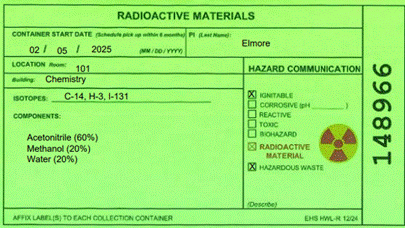
Figure 1. HWL-R filled out completely.
- All radioactive waste containers must have a complete HWL-R affixed to them immediately upon first use and include the following information:
- Managing liquid waste
- Storing liquid waste
- EHS supplies plastic gallon bottles for collection of liquid radioactive waste.
- Always use secondary containment such as a bucket or tub that is equal to or greater than the volume of the EHS provided 1 gallon bottle. Trays with a small lip are not sufficient to capture the volume of the primary container in the event it spills. PIs are responsible for providing secondary containment, not EHS.
- Keep the container closed when not in use.
- Do not store containers in fume hoods.
- If using a funnel to fill the container, do not leave the funnel in the container when not in use. Store the funnel in secondary containment.
- Keep the pH in the range of 5.5-9.5 if possible. If this is not possible, contact EHS prior to generating the waste.
- Do not dispose of any radioactive liquids down the sink. When cleaning any contaminated containers, collect the rinsate as radioactive waste.
Below in Figure 2 is an example of an appropriately stored liquid waste container.

Figure 2. Liquid waste container stored appropriately in secondary containment.
- Preparing for pickup
- Ensure the lid is fully closed and secured on the bottle. Bottles must remain in secondary containment until picked up by EHS. Survey and swipe the outside of the bottle for external contamination.
- If the liquid waste container has been identified as mixed waste, then EHS will place a “sealed” label on the lid and pick it up during the next EHS waste shipment. If a container has been deemed mixed waste and is sealed, it must remain at the point of generation until EHS transfers it to the EHS waste facility for shipment. This may take greater than the acceptable timeframe of 12 months for ram waste containers to remain in labs. PIs will not receive a violation in this instance for an outdated container if it is stored properly.
- Storing liquid waste
- Managing solid waste
- Storing solid waste
- In most cases, solid ram waste will be kept in EHS approved containers such as cardboard boxes with thick plastic liners.
- Solid RAM waste includes materials such as paper, plastic, used PPE, empty stock vials, etc.
- Always close the plastic liners before closing the cardboard box.
- Never allow the waste to get in between the plastic liner and cardboard box.
- Never dispose of lead in solid waste. Uncontaminated lead may be given to Surplus Properties or submitted to EHS. Notify EHS during the waste pickup request process that lead needs to be disposed of and ensure that the lead is not contaminated prior to EHS pickup. Do not dispose of lead in the regular trash. If lead is found to be contaminated, contact RSS for additional instructions.
- Do not place free liquids or containers that do not meet the RCRA definition of "empty" in solid waste containers. If needed, absorbent materials can be used to minimize any residual liquids which may be placed into solid waste.
- Emptied stock containers may be placed in a solid waste container provided there is only one mL or less of liquid in the vial. Quantities greater than one mL of liquid should be bulked into one of the EHS provided plastic bottles.
The bottom of the box should be secured with strong packaging tape in an “H” pattern to prevent gapping at box fold and edges, as shown in Figure 3. No masking or other less substantial tape may be used.
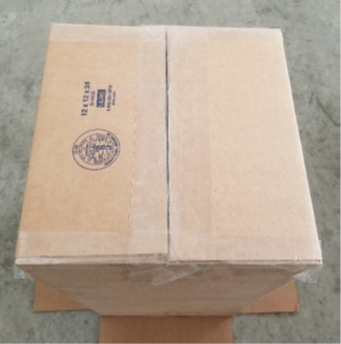
Figure 3. Example of how to tape and secure the bottom of a solid waste container.
Place an EHS provided liner inside the box and place the HWL-R on the side of the box so it is clearly visible, as shown in Figure 4.
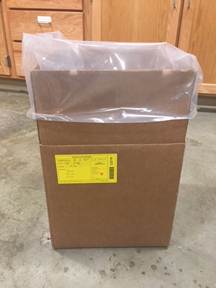
Figure 4. Example of liner appropriately placed inside cardboard box and labeled with HWL-R, ready for radioactive solid waste use.
- Preparing for pickup
Before submitting a solid waste container for pickup, it must be sealed appropriately as shown in Figure 5a-e. Close the box before it is completely full. Twist each bag closed being careful not to force air into your face. Fold the neck over and zip tie the bend in the neck closed as shown in the pictures below. Do this for both the inner and outer bag when applicable.
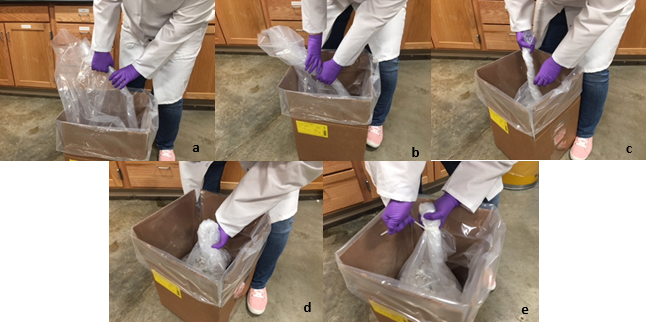
Figure 5a-e. How to properly and safety close and secure the plastic liner in a solid waste cardboard box container.
Fold down the flaps of the box and securely tape them shut with strong packaging tape in an “H” pattern to prevent gapping at the box fold and edges, as seen in Figure 6.
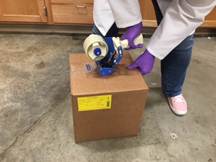
Figure 6. How to secure the top of a solid waste cardboard box.
- Survey and swipe the outside of the box for contamination. The dose rate and removable contamination results will be used when submitting a Waste Pickup Request.
- Storing solid waste
- Managing sharps
- Storing sharps
- Sharps pose puncture hazards and must be stored in a strong, puncture-proof container like the one in Figure 7. EHS does not provide such containers, therefore the PIs must purchase sharps containers from outside sources such as laboratory equipment suppliers.
- In general, PIs who generate sharps that are both biologically and radiologically contaminated use short-lived radionuclides which can be held for decay; after decay, these containers can be disposed of as biological sharps waste. If a PI plans to generate biologically and radiologically contaminated sharps with radionuclides which have half-lives >120 days, then EHS must be contacted before waste generation to ensure the waste can be disposed of properly.
When sharps are contaminated with both radiological and biological hazards, the container must be labeled to clearly indicate all present hazards. A sharps container specifically designed for biohazardous materials (sometimes referred to as a “biohazard sharps container”) is appropriate for this dual hazard waste stream, as shown in Figure 7.
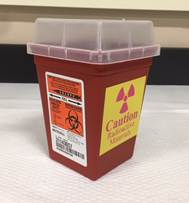
Figure 7. Sharps box with both radioactive and biohazard labels.
- Plastic pipette tips are not considered sharps for disposal purposes if they are placed directly into the EHS provided cardboard boxes with plastic liners.
- Sharps that are only radiologically contaminated and do not present a biological hazard can be placed in another puncture-proof container, such as an EHS-provided liquid waste container if they fit. If the radiologically contaminated sharps do not fit into an EHS liquid waste container, then the PI must supply an alternative puncture-proof container such as the sharps container shown in Figure 7. Regardless of the container used, it must be labeled on the outside with an HWL-R.
- Preparing for pickup
Full sharps containers that do not require a biohazard designation can be placed into an approved EHS container, likely a cardboard box with a plastic liner as shown in Figure 8.
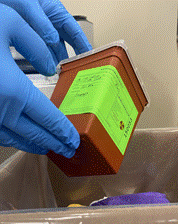
Figure 8. Once full, sharps containers can be placed directly into solid waste cardboard boxes with plastic liners as long as a biohazard is not also present.
- When placing the sharps container inside the cardboard box, either remove the HWL-R from the sharps container and affix it to the outside of the cardboard box or place a new HWL-R on the cardboard box.
Clearly indicate the contents by writing “Contains Sharps” or similar identifying language on the box exterior, as shown in Figure 9.
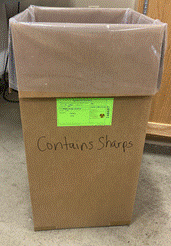
Figure 9. When placing sharps containers into solid waste cardboard boxes, it is beneficial for the EHS Hazmat team to know if the waste contains sharps. Therefore, it is recommended to also indicate such on the outside of the solid waste container.
- Securely close the plastic liner around the sharps container before closing the cardboard box. If the sharps container does not fit into the standard EHS approved waste container, contact EHS prior to generating the waste to arrange for appropriate containers.
- Proceed with closing the box as previously described in Section 4.4 Managing Solid Waste.
- Storing sharps
- Managing scintillation vials
- Storage scintillation vials
- Liquid scintillation (LSC) vials should be stored in solid waste cardboard box containers with a plastic liner.
- To minimize the volume of radioactive waste, LSC vials with activity should be kept in separate containers from zero activity LSC vials.
Ensure the caps are tightly secured on each vial before disposal as shown in Figure 10. It may be beneficial to use two plastic liners to prevent leakage.
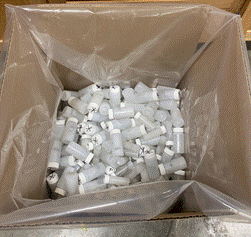
Figure 10. Close caps in LSC vials to prevent leakage. Separate LSC vials into their own solid waste cardboard box containers.
- Use biodegradable or environmentally friendly liquid scintillation cocktails. Avoid flammable scintillation materials as this could generate mixed waste.
- When filling out the HWL-R, label zero activity LSC vials as “swipes,” without any radionuclide if all the swipe results are below the RSM’s trigger levels.
- Preparing for pickup
- Prepare the cardboard box the same as described in Section 4.4 Managing Solid Waste.
- Storage scintillation vials
- Managing animal carcasses
- Storing animal carcasses
- Collect small animal carcasses or animal tissues containing radioactive materials in plastic bags and keep frozen. EHS does not supply these plastic bags, only the inner liners of cardboard boxes.
- If larger animal carcasses may be generated, contact EHS beforehand to ensure disposal can be completed.
- Place the HWL-R onto the plastic bag.
- Preparing for pickup
- All animal carcasses or tissue being stored for rad waste pickup should be kept in a freezer until time of pickup. Survey and swipe the outside of the bag for external contamination. The dose rate and removable contamination results will be used to submit a waste pickup request.
- Storing animal carcasses
- Managing original stock items and containers
- Storing original stock items and containers
- If the stock vial is not empty, place it in a shielded container such as a lead “pig” and keep it separate for pickup.
If the stock vial is empty or has residual liquids as previously described, it can be placed in solid radioactive waste with the top unscrewed from the container as shown in Figure 11.
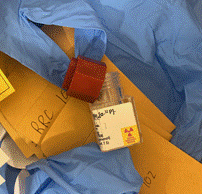
Figure 11. Dispose of empty stock containers in solid waste with the cap unscrewed.
- Storing original stock items and containers
- Requesting a waste pickup
- Once the containers are prepared, submit a pickup request. Instructions on how to submit the request can be found on the EHS website.
- Records of the pickup request are maintained by EHS.
- EHS will try to complete requested pickups within two weeks of the request. If information regarding the pickup is incomplete, this may delay the pickup process.
- Once the containers are prepared, submit a pickup request. Instructions on how to submit the request can be found on the EHS website.
- Decay-In-Storage (DIS) per 10 CFR 35.92
- To be approved for DIS, PIs must submit an amendment to their RAM permit.
- Per MU’s NRC Radioactive Materials License (RML), all ram with a half-life less than or equal to 120 days may be stored for DIS [MU NRC RML 24-00513-32 Amendment #133 License Condition 23].
- Radioactive waste held for DIS cannot be stored for longer than four years [MU NRC RML 24-00513-32 Amendment #133 License Condition 23].
- All radiation labels must be removed or obliterated, except for labels on materials that are within containers that will be managed as biomedical waste after they have been released from MU’s license [10 CFR 20.1904(b)].
- Even if a waste container has decayed an appropriate amount of time and meets the requirements for DIS, it cannot be disposed of as ordinary trash if other hazardous material is present.
- Containers shall be held for 10 half-lives from the longest-lived radionuclide before surveying for disposal.
- When disposing, the container must not provide any interposed shielding for the material; all shielding must be removed before surveying. It is MU’s interpretation of the term “interposed shielding” and 10 CFR 35.92 that the outer casing of manual brachytherapy seeds does not count as interposed shielding, thus allowing them to be disposed of via DIS.
- When sealing a container and placing it in DIS, fill out an HWL-R with the date sealed and all radionuclides in the container. Then fill out the DIS log with the appropriate information. See Appendix A for a template of a DIS log that complies with 10 CFR 35.2092.
- For any unused patient doses, ensure that no long-lived contaminants are present before disposing as DIS. Specifically, if a Lu-177 is marked on the batch release record as “No Carrier Added”, then it can be safe to assume no long-lived contaminants will be present and the unused dose can be disposed via DIS if the dose rate measured with an appropriate detector is indistinguishable from background. If the unused dose is indicated as “Carrier Added,” it will need to be transferred to an approved waste vendor for final disposal. Unused patient doses that are “No Carrier Added” do not need to have liquid samples taken and analyzed on an LSC as long as the dose rate measured with an appropriate detector is indistinguishable from background.
- Before disposal as ordinary trash, perform the following steps:
- Ensure that the survey meter is calibrated and perform an operational meter check.
- Survey the waste at the container surface with an appropriate survey meter set on the most sensitive scale
- Remove any shielding from the container.
- Survey the waste in a low background area away from other sources of radiation, if possible, especially if there are low levels of beta emitters such as S-35 in the waste.
- Monitor all surfaces of the container.
- Remove or deface any radioactive material labels unless managed as non-rad biomedical waste per 10 CFR 35.92.
- Dispose of the waste into ordinary trash only if the previous steps are complete and the dose rates are indistinguishable from background.
- Fill out the DIS log. See Appendix A for an example DIS log.
- If the waste still provides distinguishable dose rates, return to the DIS storage facility for further decay. If a container does not seem to be decaying as expected, contact RSS for disposal as radioactive waste.
- All DIS records must be retained for three years per 10 CFR 20.2108. The record must contain information listed in 10 CFR 35.2092. The DIS log in Appendix A meets these requirements. Information includes:
- Date of disposal
- Date waste was placed in storage
- Radionuclide(s) disposed
- Survey instrument used
- Background dose rate
- Dose rate measured at the surface of each waste container
- Name of individual performing disposal
- For veterinary medicine DIS liquid waste:
- Since the nature of Veterinary Medicine DIS liquid waste provides self-shielding, particularly due to the large volumes and inaccessibility of the tanks, it cannot be surveyed to determine if it’s indistinguishable from background.
- In most instances, the DIS tanks are not set up to be easily sampled either. Therefore, it is best practice to consider this waste not as DIS but rather a regular release to the sanitary sewer.
- Periodically, the RSS will obtain reports from the veterinary medicine staff that list the radionuclide and assay date as well as the DIS logs which include the date the tanks are released. This information can be used to calculate the amount of decayed activity that is released to the sanitary sewer as compared to the Monthly Average Concentration values in 10 CFR 20 Appendix B Table 3 Releases to Sewers. This information can then be documented as part of either a Health Physicist’s audit, the annual Radiation Safety Program audit, or another appropriate location.
- The Veterinary Medicine Staff will continue to hold the DIS tanks for 10 half-lives prior to release and follow all DIS procedures. However, the RSS will document such waste as releases to the sewers.
If liquid waste needs to be sampled prior to disposal after DIS, then the Critical Level (Lc) can be used to ensure the sample does not contain measurable radioactivity above background. The standard confidence level of 95% (i.e., a 5% false positive rate) is used in the below equation.

Where
Lc = Critical level [cpm]
2.33 = Constant associated with a 95% confidence interval assuming the sample and background counting times are equal
Rb = Background count rate [cpm]
tb = Background count time [cpm]
- Calculate the Lc for the instrument to be used.
- If the net cpm of a sample is < Lc, then the sample passes (i.e., does not have radioactivity statistically distinguishable from background).
- If the net cpm of a sample is > Lc, then the sample fails (i.e., does have radioactivity statistically distinguishable from background).
- Any samples that pass the test previously described may be disposed down the sanitary sewer as non-radioactive waste.
- Any samples that do not pass the test should be resampled to verify the results. If the sample continues to fail after three independent sampling events, then the waste must be disposed of as radioactive.
- This method of release for DIS waste may only be necessary if meter surveys do not provide definitive results that the liquid waste is indistinguishable from background.
- Release of liquids to sanitary sewerage [10 CFR 20.2003]
- MU EHS no longer disposes of radioactive waste into sanitary sewers unless it has been decaying and meets the DIS requirements. However, in the chance that waste is released into the sanitary sewers, the following requirements must be met.
- Prior to disposal, provide a list of all items being poured into the drain to a Health Physicist for review and approval. The Health Physicist will evaluate if the material may be disposed of to the sanitary sewers if each of the following conditions is met [10 CFR 20.2003]:
- No other hazards are present in regulated quantities as determined by Hazardous Materials Services.
- The material is readily soluble or is readily dispersible biological material in water; and
- The amount of each radionuclide does not exceed the monthly and annual discharge limits specified in 10 CFR 20.2003(a)(4) and in 10 CFR 20 Appendix B Table 3.
- If more than one radionuclide is released, then the following must be met:
- The limit for the amount released must be determined using the sum of fractions for the limits of each radionuclide in 10 CFR 20 Appendix B Table 3, and the sum must not exceed unity (i.e., one); and
- The total activity released in a year does not exceed 5 Ci of H-3, 1 Ci of C-14, and 1 Ci of all other ram combined.
- The sum of fractions rule must be used when multiple radionuclides are present. The sum of the ratio of each radionuclide's concentration (C) to its regulatory limit (L) must not exceed 1: ∑ (Cᵢ / Lᵢ) ≤ 1
- Where Cᵢ is the activity or concentration of each radionuclide and Lᵢ is the corresponding limit in 10 CFR 20 Appendix B, Table 3.
- The sewer system must be a Publicly Owned Treatment Works, not a private sanitary sewer, septic system, or leach field.
- Liquid waste should be discharged at designated areas only such as sinks or toilets.
- Discharge the liquid waste slowly to minimize splashing, and use running water to ensure the material moves out of the sink or container.
- Survey the sink and surrounding work surfaces to confirm no residual material or contamination remains and decontaminate as necessary. Document all results on a survey map.
- Maintain records of each release which include:
- Release date
- Radionuclide(s)
- Estimated activity of each radionuclide
- Location where material is discharged
- Initials of individual discharging waste
- Records of release should also demonstrate compliance with the regulatory limits for total quantity released and concentrations released by the facility.
- Disposal by incineration
- MU no longer has a working incinerator, so incineration is not an anticipated method of disposal. If MU were ever to obtain another incinerator, then this procedure may be updated to reflect its usage and follow 10 CFR 20.2004 as well as NUREG 1556 Vol 7 Rev 1 Appendix P.
- Disposal by compaction
- MU does not anticipate disposing of radioactive waste by compaction. If MU ever obtains means to perform compaction, this procedure will be updated.
- Transfer for disposal (to and from MU’s license)
- Per MU’s NRC RML, waste transferred from other MU licenses shall be disposed of within one year of receipt [MU NRC RML #24-00513-32 Amendment #133 Condition 25].
- For generators that are being transferred back to the manufacturer (such as the Rb-82 generator) or other offsite shipments, ensure that EHS-SOP-RAD-601 “Offsite Shipments of RAM” is being followed.
- For transfers of waste from MU, such as to waste vendors, the RSS must verify the intended recipient is authorized to receive the radioactive shipment prior to transfer. This can be done by having the recipient’s radioactive materials license on file. The RSS will work with the vendor to ensure that any special requirements for disposal are met such as specific packaging for the recipient for final disposal.
- Most waste at MU will be disposed of through a contracted waste vendor. The waste vendor assumes the responsibility to prepare a manifest in accordance with 10 CFR 20 Appendix G “Requirements for Transfers of Low-Level Radioactive Waste Intended for Disposal at Licensed Land Disposal Facilities and Manifests.” EHS staff will prepare a list of waste items for the vendor. After generation of the manifest, EHS staff will verify the accuracy of the manifest prior to pickup.
- Patient excreta
- Per 10 CFR 20.2003(b), excreta from patients or human research subjects receiving ram procedures regulated under 10 CFR 35 are exempt from the requirements for releasing liquids to the sanitary sewer.
- If excreta are collected, then they no longer count as exempt per 20.2003(b) and must be treated as radioactive waste.
- Occasionally, prostate implant brachytherapy seeds may be voided into the toilet. If this occurs, the seeds do not need to be collected; they can be flushed to the sanitary sewers per 10 CFR 20.2003(b). If the seeds are collected, they must be treated as radioactive waste.
- Exempt source disposal
- Waste from in vitro kits that are generally licensed under 10 CFR 31.11 are exempt from 10 CFR 20 waste disposal requirements. However, radioactive labels should be defaced or removed [10 CFR 20.1904(b). Records of this disposal are not required.
- Exempt sealed sources, such as button check sources, should be treated as radioactive waste. See EHS-SOP-RAD-504 “Exempt Quantity Sources” for additional requirements.
- Source material that is generally licensed under 10 CFR 40, including natural uranium, depleted uranium, and natural thorium, must be disposed of as radioactive waste.
- Disposal of specific waste as if it were not radioactive (NUREG 1556 Vol 7 Rev 1)
- Per 10 CFR 20.2005 “Disposal of specific wastes”, “cold” non-radioactive LSC vials containing swipes and scintillation cocktail can be disposed of as nonradioactive waste. Additionally, these types of containers can be disposed of as nonradioactive if there is no more than 0.05 μCi of H-3 or C-14 per gram of medium.
- Animal carcasses or animal tissue containing no more than 0.05 μCi of H-3 or C-14 per gram averaged over the weight of the entire animal may be disposed of as non-radioactive waste. If an animal will be disposed of as nonradioactive waste as previously described, then the RSS must ensure that the animal will be disposed of in a manner that will not permit the use of it as food for humans or animals.
- Prior to disposal via this method, a RAM permit amendment must be submitted that includes the justification for the process and disposal methods.
- Mixed Waste
- Mixed waste must be minimized at the point of generation whenever possible due to limited and expensive disposal options. Seek out non-hazardous alternatives where possible.
- Prior to generating mixed waste, contact EHS to ensure appropriate labeling, storage, and disposal pathways are in place. A mixed waste determination will be made in consultation with the RSO and Hazmat Manager.
- Store mixed waste separately from other radioactive or hazardous waste streams. Label containers with both the “Radioactive Hazardous Waste” label and applicable hazardous waste indicators (flammable, corrosive, etc.).
- General MU waste requirements
- References:
- Radiation Safety Manual - Radioactive Waste Requirements
- Radiation Safety Manual - Transferring and Disposing of RAM
- 10 CFR 20
- 10 CFR 35
- NUREG 1556 Volume 11 Revision 1
- NUREG 1556 Volume 7 Revision 1
- NUREG 1556 Volume 9 Revision 3
- MU NRC RML (on file at EHS)
- Regulatory Issue Summary 2004-17, Revision 1, Revised Decay-In-Storage Provisions For The Storage of Radioactive Waste Containing Byproduct Material, September 2005
- Revisions
- Rev 00
- New SOP – Replaces the following SOPs, Working Guides, and Radiation Safety Manual pages
- RSIP-W-01.03 Decay in Storage of Solid Radioactive Waste
- RSIP-W-02.02 Mixed Waste Storage and Handling Procedure
- RSIP-W-03.02 Procedures for Incineration of Radioactive Waste
- RSIP-W-04.01 Release to Sanitary Sewer
- RSIP-W-06.01 Bulking of Liquids for Storage
- RSIP-W-07.00 Radioactively Contaminated Biohazardous Waste
- RSIP-W-08.02 Disposal of Radioactive Medical Unwanted Materials (Waste)
- RSIP-W-14.00 Offsite Shipment of Radioactive Waste
- RSIP-W-15-C1.00 Checklist for Sanitary Sewer Record for Clydesdale
- Radiation Safety Manual - Transferring and Disposing of RAM
- Removed information from this page about RAM waste and added to the SOP.
- EHS-WG-RAD-100.01 Radioactive Waste Packaging Guidelines
- MUHC Disposal of Radioactive Medical Waste
- New SOP – Replaces the following SOPs, Working Guides, and Radiation Safety Manual pages
- Rev 00